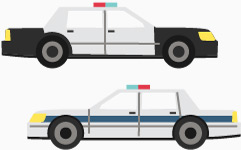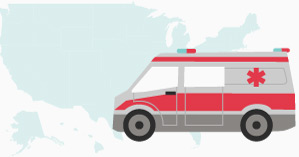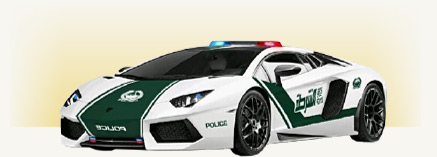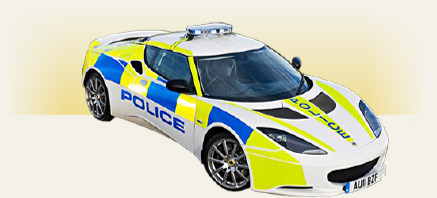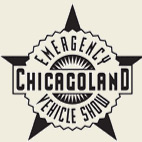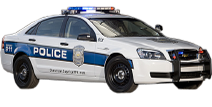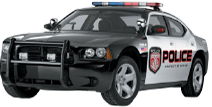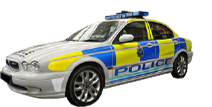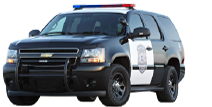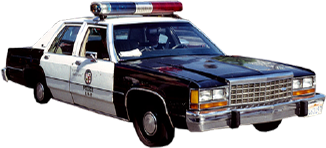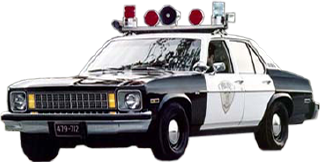Police Car History
The History of
the Police Car
All Hail the Black and White
A police car is a vehicle that most of us take for granted. In fact, you may not appreciate the true purpose of a patrol car until you’re in need of help.
A police car is driven by the police force during daily patrol and in response to emergency calls. For this reason, a police car must be reliable, fast, and well-made. A speedy response to an accident or crime scene is critical to save a life.
Early law enforcement didn’t always have efficient transportation.
The first electric-powered patrol wagon used for police squads was invented in 1899 by the Akron Police Department.
This squad car was much-needed to streamline police transportation and organize law enforcement response. The early patrol wagon was powered by electricity at speeds up to 18 mph; it was able to travel roughly 30 miles before recharging the battery.
The Akron police wagon was designed by Frank Loomis and manufactured by Collins Buggy Co. of Akron, Ohio, for an estimated $2400. The squad wagon came with all the bells and whistles to differentiate it as a police vehicle-electric lights, a warning bell, a stretcher, and seating capacity for 12 prisoners.
Unfortunately, the revolutionary electric Akron police wagon was short-lived. Just one year later, in 1900, the electric wagon was pushed into the Ohio Canal during a race riot. Once the wagon was pulled out of canal, it served the police force for a few short years before it was “retired” for good. In 1905, the first police car in the US was sold scrap for $25.

first electric-powered patrol wagon
- Designed by Frank Loomis
- Manufactured by the Collins Buggy Co.
-
30
miles
-
18
mph
-
12
seat for
prisoners -
$2400
estimated
price

This early police car innovation set the stage for police transport in the century to come. Police cars—commonly called patrol cars, squad cars, cop cars, and cruisers—became invaluable to the police force. The use of a dependable vehicle for officers on duty allowed for an even quicker response time. Patrol cars helped officers cover a larger area of the city in a shorter amount of time. Police cars were also used to carry equipment, multiple officers, criminals, or those in need of help.
Police car nicknames vary around the world and may include:
- jam sandwich
- panda car
- black and white
- cherry top
- gumball machine
- whale
- paddy wagon
Patrol cars today have come a long way. You may have a whole new appreciation for the average cop car after reading these little-known facts.
Did you know…?
-
1
A response car is different from a patrol car since it is capable of a higher speed for emergencies and chases.
-
2
K9 police units have a special dog unit car to transport police dogs, normally a station wagon or van that can hold dog crate cargo.
-
3
Police cars are marked with retroreflective paint to efficiently reflect light with minimal scattering.
-
4
Most modern cruisers are outfitted with diesel engines to cut fuel costs.
-
5
All police cars include specialized safety equipment, such as fire extinguishers, first aid kits, flares, life buoys, and automated external defibrillators (AEDs).
-
6
Police car fleets are managed with specially designed keys for the utmost in security.
-
7
Police vans are called “meat wagons” in the UK, though “meat wagon” often indicates an ambulance in the US.
-
8
Police squads drive powerful Lamborghinis in Dubai since most private citizens drive fast cars.
-
9
The fastest police car in Britain is the Lotus Evora with a top speed of 160 mph, intended to intimidate criminals.
-
10
Specialty police cars as collectors’ items are sold through the annual Chicagoland Emergency Vehicles Show in Illinois.
Common Types of Police Cars
-
Patrol car
Conveys normal police officers between their duties and also enables them to respond to emergencies.
-
Response car
Higher specification, capable of faster speeds and fitted with audible and visual warnings.
-
Traffic car
Designed for the job of enforcing traffic laws and capable of catching most other vehicles on the road.
-
Sport Utility Vehicles (SUV)
For a variety of reasons off-road needs, applications where a lot of equipment must be carried, or K-9 units.
Source: spillman.com
The Evolution of the Patrol Car
Decade by Decade
The evolution of the police car is much more than meets the eye. Here are some of the most important milestones in patrol car history:
-
The first electric police wagon was introduced in Akron, Ohio, with a top speed of 18 mph.
-
The Radio Motor Patrol squad car fleet was used by the New York City Police Department to fight crime. Within the decade, police departments throughout the US transitioned from inexpensive motorcycles to squad cars with radio to cover a larger territory; upgraded squad cars with two-way wireless radio saved money by eliminating the use of street-corner telephone call boxes.
Two-way radios served an added benefit in centralizing police communication to more effectively attack crime.
-
Plymouth began producing armor-plated police vehicles, such as the famous Kansas City Hot Shot, to protect the police force against Thompson submachine guns used by criminals—a.k.a. the Tommy Gun.
-
-
Chrysler produced their first and last official police package in the Chrysler Enforcer, used for several years by the police force.
-
Within the decade, squad cars were downsized to smaller Ford LTD and Chevrolet Caprice vehicles.
-
Police car designs slumped in the late 1970s and early 1980s; most police departments preferred no-frills Plymouth Volare and Ford Fairmont prototypes.
-
-
The police force eliminated the Chevrolet Caprice patrol car design in favor of the standard Ford Crown Victoria Police Interceptor patrol car. The Crown Victoria was supremely popular for police car use due to its conventional rear-wheel drive design, powered by a V-8 engine; rear-wheel drive was advantageous as it offered better control and durability in hard-driving environments.
-
The Ford Model T was considered the only affordable police car choice of the time, powered with a 20 hp, four-cylinder engine with a top speed of nearly 45 mph.
Most police cars in the early 1900s were modified from manufactured vehicles, before automakers produced niche police packages.
-
The Ford Model T police truck became known as the “paddy wagon,” used to haul drunken citizens disturbing the peace in a holding cage.
-
Ford produced the Ford Flathead V-8 Model 8 as an affordable, mass-marketed vehicle; the Model 8 was used by the police force until 1968.
In addition to police use, the high-power Model 8 was also a favorite of criminals like Bonnie and Clyde to outrun patrolmen in police chases.
-
Within the decade, GM, Ford, and Chrysler produced specialty police packages with severe duty parts for the patrol car market; a “police package” indicated a specially equipped car manufactured specifically for police work.
-
1950The Ford Motor company police package debuted.
1955
The Chevrolet police package debuted.1956
The Dodge police package debuted. -
Plymouth took the lead in police car production thanks to powerful Chrysler V-8 engines that remained the preferred PD choice until the energy crisis of the 1970s.
-
The 1975 Chevrolet Nova police package was considered the most popular compact police vehicle of the decade. Called the “ultimate police car,” the Nova was built with a 350 in.³ 4-barrel carbureted V-8 engine at 155 hp for use as a pursuit vehicle.
-
The impressive Ford Mustang LX Highway Patrol Edition was favored by the Texas DPS from 1983 to 1993; performance improved in police patrol and pursuit due to the 5.0 L V-8 engine.
-
Squad car redesign expanded within the decade into three distinct categories: police pursuit cars for everyday use, special service vehicles driven by government agents, and specialty service packages that included police sports cars.
-
Carbon Motors developed the first purpose-built E7 squad car prototype with a projected release date of 2012. The specially designed law enforcement vehicle featured rear-hinged doors for expedient passenger loading, quick acceleration from 0 to 62 mph in 6.5 seconds, and a top chase speed of 155 mph.
-
Beloved Ford Crown Victoria police cars were discontinued in favor of the sixth generation Ford Taurus.
-
The first electric police wagon was introduced in Akron, Ohio, with a top speed of 18 mph.
-
1909
The Ford Model T was considered the only affordable police car choice of the time, powered with a 20 hp, four-cylinder engine with a top speed of nearly 45 mph.
Most police cars in the early 1900s were modified from manufactured vehicles, before automakers produced niche police packages.
-
1919
The Great Depression caused a slump in the sporty convertible industry.
-
1920
The Radio Motor Patrol squad car fleet was used by the New York City Police Department to fight crime. Within the decade, police departments throughout the US transitioned from inexpensive motorcycles to squad cars with radio to cover a larger territory; upgraded squad cars with two-way wireless radio saved money by eliminating the use of street-corner telephone call boxes.
Two-way radios served an added benefit in centralizing police communication to more effectively attack crime.
-
1932
Ford produced the Ford Flathead V-8 Model 8 as an affordable, mass-marketed vehicle; the Model 8 was used by the police force until 1968.
In addition to police use, the high-power Model 8 was also a favorite of criminals like Bonnie and Clyde to outrun patrolmen in police chases.
-
1933
Plymouth began producing armor-plated police vehicles, such as the famous Kansas City Hot Shot, to protect the police force against Thompson submachine guns used by criminals—a.k.a. the Tommy Gun.
-
1940
Within the decade, GM, Ford, and Chrysler produced specialty police packages with severe duty parts for the patrol car market; a “police package” indicated a specially equipped car manufactured specifically for police work.
-
1950The Ford Motor company police package debuted.
1955
The Chevrolet police package debuted.1956
The Dodge police package debuted. -
1960
Chrysler produced their first and last official police package in the Chrysler Enforcer, used for several years by the police force.
-
1969
Plymouth took the lead in police car production thanks to powerful Chrysler V-8 engines that remained the preferred PD choice until the energy crisis of the 1970s.
-
1970
Within the decade, squad cars were downsized to smaller Ford LTD and Chevrolet Caprice vehicles.
-
1975
The 1975
Chevrolet Nova police package
-
1980
Police car designs slumped in the late 1970s and early 1980s; most police departments preferred no-frills Plymouth Volare and Ford Fairmont prototypes.
-
1983
The impressive Ford Mustang LX Highway Patrol Edition was favored by the Texas DPS from 1983 to 1993; performance improved in police patrol and pursuit due to the 5.0 L V-8 engine.
-
1990
Squad car redesign expanded within the decade into three distinct categories: police pursuit cars for everyday use, special service vehicles driven by government agents, and specialty service packages that included police sports cars.
-
-
1996
The police force eliminated the Chevrolet Caprice patrol car design in favor of the standard Ford Crown Victoria Police Interceptor patrol car. The Crown Victoria was supremely popular for police car use due to its conventional rear-wheel drive design, powered by a V-8 engine; rear-wheel drive was advantageous as it offered better control and durability in hard-driving environments.
-
2008
Carbon Motors developed the first purpose-built E7 squad car prototype with a projected release date of 2012. The specially designed law enforcement vehicle featured rear-hinged doors for expedient passenger loading, quick acceleration from 0 to 62 mph in 6.5 seconds, and a top chase speed of 155 mph.
-
2011
Beloved Ford Crown Victoria police cars were discontinued in favor of the sixth generation Ford Taurus.
was considered the most popular compact police vehicle of the decade. Called the “ultimate police car,” the Nova was built with a 350 in.³ 4-barrel carbureted V-8 engine at 155 hp for use as a pursuit vehicle.

Police forces adopted the sixth generation Ford Taurus in 2012 as a 2013 patrol model; the specialty vehicle was dubbed the Police Interceptor Sedan and included all-wheel drive, a rearview camera, a reverse sensing system, and the Ford Blind Spot Information System.
-
In the early days of police transport, far before squad car fleets, police officers primarily rode motorcycles.
However, the true purpose of police transport was, and always has been, a speedy response to criminal activity. Once criminals began using cars in the early 1900s, police had to match their method of transportation. Motorcycles were sidelined for faster police vehicles in various makes and models.
-
Police car design and coloring has also transformed over the decades.
North American police cars were once exclusively black and white; the “red and blue” association refers to the flashing red and blue police lights. Rural police departments and sheriff’s offices often drive police packages in brown, beige, and tan.
Police car styles and designs today will vary greatly by law enforcement agency.
A state patrolman may drive a more contemporary cruiser on his watch; a sheriff’s department normally will not drive a pursuit-specific vehicle with a higher speed capacity; a police K9 unit will often use a specialty vehicle to hold equipment and police dogs, such as a van or SUV.
The Future of
the Black and White
To keep an edge on criminal activity, police vehicle technology is constantly changing.
Tech-forward police instruments are vital to police monitoring, pursuit, and emergency response. Some of the most popular police transport equipment includes:
-
Automatic License Plate Recognition: Fixed or mobile technology can be used as an automatic license plate recognition (ALPR) system integrated with in-car camera equipment. The ALPR system can record vehicle license plates and process numbers and letters using optical character recognition software within a police database.
-
Helicopter Drones: Helicopter drones are considered a police vehicle, used to assist automobile cruisers by providing an aerial view for surveillance, chase, or emergency response.
-
Speed Recognition Device: In-car device used to track the speed of cars being followed on the road.
-
In-Car Camera Systems: In-car recording technology has become invaluable to the police force; recording video footage from within a patrol car can provide legal protection in routine traffic stops, arrests, and criminal investigations.
-
-
Vehicle Tracking System: Automatically alerts a police officer if a stolen vehicle is in the vicinity, using a transponder with GPS or radio triangulation guidance.
-
Hidden LED Lights: Hidden LED police lights are the trademark of an unmarked police car, often used in traffic stops to catch unsuspecting drivers in the act.
-
-
Two-Way Radios: Police car communication systems have come a long way since the introduction of the first two-way radio.
-
Low Frequency Sirens: Blaring, high-pitch police car sirens have been replaced with low frequency sirens, used to alert distracted drivers or signal an emergency dispatch.
-
Runlock: Police car engines can be left running without leaving the keys in the ignition.
-
In light of this new technology, police forces throughout the US are constantly testing new squad car designs.
To keep up with fast-paced, innovative civilian vehicles on city streets, police cars must be upgraded with the latest features.
Depending on where you live in the country, police car designs and uses may vary. A city like Detroit focused on improving public safety rolled out 100 new police cars in their fleet, along with 23 ambulances, in 2013.
With $8 million in donations, the Detroit police force was given a much-needed facelift. The newest police vehicle designs included the Ford Taurus Interceptor, the Dodge Charger Pursuit, and the Chevrolet Caprice Police Pursuit Vehicle. Other police forces, including the Richmond Police Department, have followed suit in new police car designs and color schemes—complete with better fuel economy, updated safety features, and lower emissions.

Modern police cars are a staple in every police department throughout America.
Police technology and safety features are continually updated to improve patrol efficiency and response time. The sleepy, oversized police car of decades past is long gone. It has been replaced with a contemporary cop car on every corner—marked by sleek design, impressive speed, and multifunctional electronic monitoring equipment.
Sources:
- “History of America’s First Motorized Patrol Vehicle.” Vehicles.
- “History of Police Cars….” The History of Police Cars.
- “The Evolution of the Police Car.” MSN Autos.
- “Innovative deal provides 100 new police cars, 23 ambulances to boost city of Detroit public safety.” Detroit Unspun.
- CarInsuranceCalculatorOnline.com
